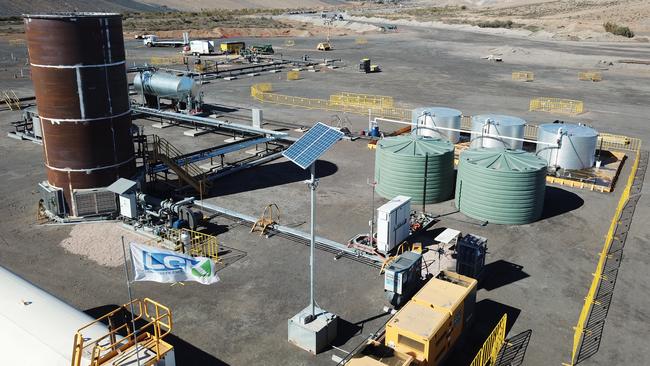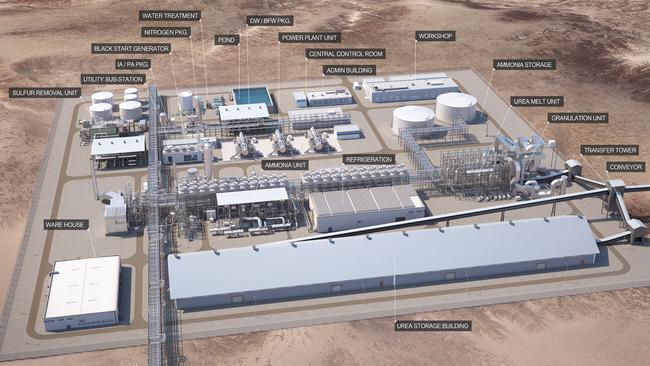NeuRizer to release initial bankable feasibility study for $2.6bn urea project
Construction of a $2.6bn urea fertilizer production facility in South Australia is a step closer amid a surge in global prices fuelled by the Ukraine conflict.

Coal-gasification and urea hopeful NeuRizer’s proposal to build a $2.6bn fertilizer production facility in outback South Australia has got the jump on competing projects in Western Australia, with the imminent release of a detailed feasibility study expected to fast-track talks with potential financiers.
The ASX-listed company, previously Leigh Creek Energy, will use its initial bankable feasibility study (BFS), to be released as early as Thursday, to spruik the 30-year project’s economic credentials to potential financiers ahead of a final investment decision later this year.
NeuRizer expects to produce the nitrogen-based agricultural fertilizer at just $US83 ($110) per tonne, compared to global prices which have reached close to $US900 ($1200) in recent weeks.
And the conflict in Ukraine is expected to send prices even higher given its impact on gas prices - a major component in urea production - and sanctions on Russia, which typically accounts for about 12-15 per cent of global urea exports.
Australia imports 2.4 million tonnes of agricultural urea annually, meeting more than 90 per cent of the country’s needs.
The looming closure of the main domestic producer, Incitec Pivot’s Gibson Island facility in Brisbane, in December, will put even more pressure on local supplies.
The NeuRizer Urea Project (NRUP) is one of at least three new urea projects proposed around Australia, with Strike Energy and Perdaman Group each planning plants in Western Australia.
However the Leigh Creek project, on a former coal mine site closed in 2015, would become the only fully integrated urea production facility in Australia, with its own source of cheap gas.

It plans to use “in-situ” coal gasification to produce “synthesis gas” for a little over $1 a gigajoule, only a fraction of the typical gas costs for industrial users.
And that gives it a major advantage over competing projects, according to NeuRizer managing director Phil Staveley.
“We’ve got everything that we need to produce urea on-site - we’ve got the gas, we’ve got the electricity from the gas, we’ve got the carbon dioxide that we need to make urea,” he said.
“They’re all stable, manageable costs, so when the gas price goes to $10 or $12 or $15, our costs stay constant $1 or $1.20.
“If we look forward, we see urea prices rising, gas prices rising but our costs are still horizontal going forward.”
NeuRizer’s proposed facility in Leigh Creek, 550km north of Adelaide, will reach its 1 million tonne capacity by the third year of operations, with the potential to increase to 2 million tonnes in the longer term.
About half of annual production will be sent overseas, with the remainder supplied to local farmers, depending on the season.
NeuRizer is looking to raise an additional $600m in debt finance to get the project off the ground, after last year securing a commitment from Korea’s Export-Import Bank to provide debt finance of $1.5bn.
Mr Staveley expects no trouble securing a financier in the coming months given the project’s strong economic case and the bullish forecast for urea prices.
“Something like 10 or 15 per cent of the world’s supply of urea comes from Russia or came from Russia, so we’ve got that pressure on the price,” he said.
“Urea was already rising in price because of a shortage of supply. You’ve got the growing population, another 2 billion people by 2050, and that population has to live somewhere so there’s less land for farming.
“We need to produce more from less, which means we’ve got to produce more urea.”
A final BFS and investment decision is expected by the end of the year, ahead of the start of construction early next year and first production at the start of 2025.
About 2000 jobs will be created during the construction stage, with 1000 ongoing jobs sourced primarily from local towns and within South Australia.
The facility has been designed to be carbon neutral from the start of operations.



To join the conversation, please log in. Don't have an account? Register
Join the conversation, you are commenting as Logout